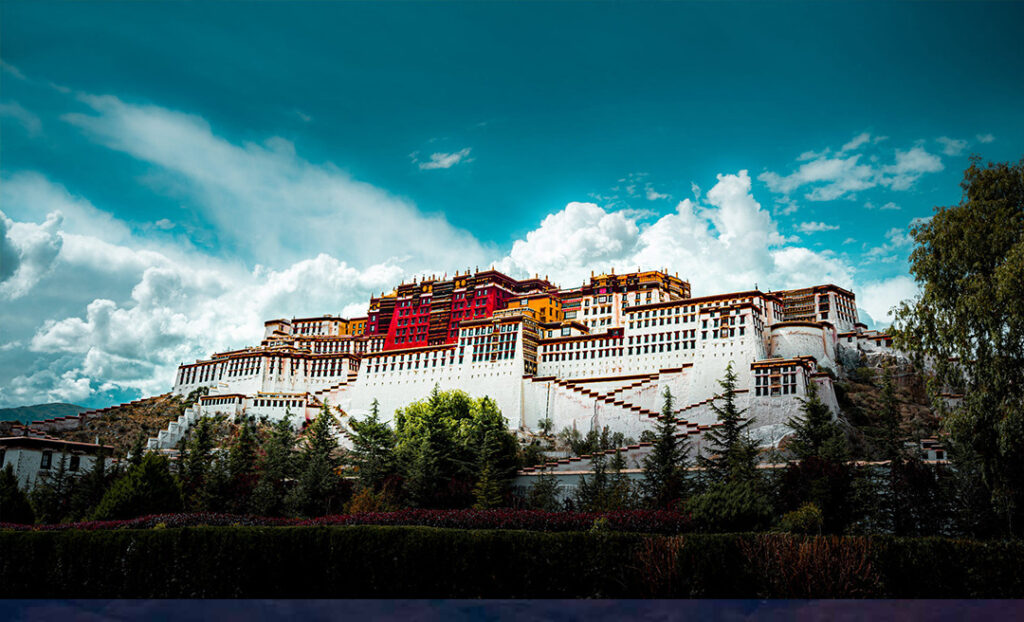Tibet, often referred to as the “Roof of the World,” is a land of unparalleled beauty and spiritual significance. Nestled in the heart of the Himalayas, Tibet offers a unique blend of ancient traditions, breathtaking landscapes, and a profound sense of spirituality. While it is now more accessible to travelers than ever before, there are essential Tibet Travel regulations and Tibet Travel guide to ensure a seamless and memorable journey to this extraordinary destination.
In this comprehensive guide, we will explore Tibet travel regulations, visa requirements, travel permits, and other vital information to help you plan your visit to this mystical land. Whether you’re an adventurer seeking high-altitude treks or a cultural enthusiast eager to explore Tibetan monasteries, this guide will provide you with the knowledge you need for a positive and optimistic journey through Tibet.

Understanding Tibet Travel Regulations
Tibet, once known as a ‘forbidden kingdom,’ has become more accessible to international travelers. Independent travel in Tibet is no longer prohibited. However, to ensure your safety and compliance with local regulations, it’s crucial to book your tour with a local Tibetan travel agency. This agency will provide you with a licensed tour guide, Make your Tibet travel permit and private vehicles for your journey. While you can choose to book your own hotel, the agency can assist you with accommodation arrangements. You have the flexibility to join group tours or opt for a private tour, depending on your preferences. In major towns like Lhasa, Shigatse, and Nyingtri, you’ll have free time to explore after visiting the key attractions.
Tibet Travel Permit: Your Gateway to Tibet
As per Tibet Travel Regulation. Before starting your journey to Tibet, you must obtain a Tibet travel permit, often referred to as a Tibet visa. This permit is mandatory for all international travelers entering the Tibet Autonomous Region. You’ll need this permit when boarding flights to Tibet from any part of China, while boarding trains to Tibet, or upon arrival at the border if traveling from Nepal. The application process for this permit can be facilitated by your travel agency in Tibet, requiring your valid passport and visa for travelers from other parts of China or only passport copies for those coming from Nepal. The permit application typically takes 18 to 30 days, depending on your planned destinations.
Additional Permits for Exploring Beyond Lhasa
While the Tibet travel permit allows you to stay in Lhasa prefecture, if your journey extends to other prefectures in Tibet, you will require additional permits. These permits are necessary when visiting multiple prefectures in Tibet or destinations near the border areas. Here are the key additional permits:
Aliens Travel Permit
The Aliens Travel Permit is essential if your tour crosses into one or more prefectures in Tibet, such as visiting both Lhasa and Shigatse prefectures. Your local guide will obtain this permit at the security bureau office in the next prefecture level headquarters, like Shigatse or Tsedang. The process usually takes a few hours.
Border Permit
The Border Permit is necessary if your journey includes destinations in border areas, such as Mount Everest or Mount Kailash. If you are travel overland or by flight from Nepal, you will need to show them at the border. Your tour guide will have this in hand upon your arrival. This permit, in addition to the Tibet travel permit, can also be obtained within a few hours. Your travel agency will handle the application process.
Military Permit
The Military Permit is required if your travel takes you into sensitive military regions of Tibet, like Ngari Prefecture (Mount Kailash region), Nyinchi Prefecture, or during an overland journey from/to Yunnan or Qinghai provinces. This permit is usually processed in Lhasa before your arrival, but it can take more than seven days to complete. If your trip necessitates this permit, allow approximately one month for all permit processing.
Accessing Tibet: Routes and Gateways
Tibet can be accessed either from other cities in China or from Nepal, offering diverse travel options. If you are traveling from Nepal, you can choose to travel overland or take a flight to Lhasa. Keep in mind that when coming from Nepal, you must obtain a Chinese Group Visa from the Chinese Embassy in Kathmandu. This visa will replace any previous Chinese visa you may have had. The process typically takes three business days, and your travel agency in Nepal will assist with the application.
For travelers coming from other parts of China, there are multiple options, including daily flights to Lhasa, Nyingchi, and Shigatse from major cities like Beijing, Shanghai, Chengdu, and more. Chengdu to Lhasa offers frequent flights. Alternatively, you can take a train to Lhasa or opt for an overland journey to and from other provinces of China.
Group Visas and Border Permits for Nepal Travelers
If your journey begins in Nepal, obtaining a Chinese Group Visa from the Chinese Embassy in Kathmandu is mandatory. Your existing Chinese visa will be revoked upon application for the group visa. It’s important to specify your entry and exit points in the visa invitation, so communicate your final itinerary to your Tibetan travel agency. Your Tibet permits will be handed to you by your tour guide upon arrival, whether at the Lhasa airport or border checkpoint.
Special Considerations for Diplomats and Journalists
Diplomats and journalists planning a visit to Tibet should be aware that different regulations apply to their travels. Local travel agencies in Tibet are not authorized to host diplomats or journalists. These professionals must contact the nearest Chinese Embassy for arrangements, as their visits are arranged by the relevant government agencies.
Timing Your Visit: Tibet’s Closure Period
Tibet typically experiences a closure period from late February to the end of March each year. During this time, the Tibet Tourism Bureau undergoes upgrades and maintenance, temporarily halting the issuance of Tibet travel permits. The permit application process resumes at the beginning of April, allowing travelers to plan their visits accordingly.
It’s important to stay updated on travel restrictions and permitted areas to ensure a smooth journey. Yet from 2024, we are hearing this halt of the Tibet travel permit will not be effective and travelers can visit Tibet in Month of March. Yet please confirm with us before making your tour plan.
Tibet Travel Services for Indian Pilgrims
Indian pilgrims traveling to Tibet for religious purposes should note that there is a dedicated route known as the Kailash Manasarovar Yatra. For Indian Citizen, You will have to book your tour with Kailash Yatra organiser in Nepal. No Normal Tibetan travel agency can help you organise the yatra.
But for Non-Indian Hindus interested in the Kailash Yatra can rest assured that local Tibetan travel agencies can facilitate their pilgrimage. These agencies specialize in organizing Kailash Yatra tours, including obtaining the necessary Tibet travel permits. Whether you are traveling from Europe, the United States, or any other part of the world, you can contact a local Tibetan travel agency directly to plan your Kailash Yatra and experience the profound spirituality of this sacred mountain.
Private Tours vs. Group Tours: Your Choice
When planning your Tibet journey, you have the option to choose between private tours and group tours. Each has its advantages, depending on your preferences:
Private Tours
Private tours offer personalized itineraries, allowing you to explore Tibet at your own pace. You can tailor your journey to specific interests and spend more time at the sites that captivate you. Private tours are ideal for those seeking flexibility and exclusivity.
Group Tours
Group tours are a fantastic way to connect with fellow travelers from around the world. They provide a cost-effective option and often include guided tours, transportation, and accommodations. Group tours offer the chance to share experiences and make new friends on your adventure through Tibet. Yet It is not mandatory to join a group tour.
Conclusion of Tibet Travel Regulations
Tibet is a land of wonder, a place where spirituality meets natural beauty, and ancient traditions coexist with modernity. By understanding Tibet travel regulations and following the guidelines outlined in this guide, you can embark on a journey that will leave you with lasting memories and a profound appreciation for the Roof of the World. Prepare for your adventure, immerse yourself in the rich Tibetan culture, and explore the breathtaking landscapes that make Tibet an extraordinary destination for travelers worldwide.
Frequently Asked Questions of Tibet Travel Regulations
Do I need a Tibet travel permit if I’m a Chinese citizen?
Yes, all travelers, including Chinese citizens, require a Tibet travel permit to enter the Tibet Autonomous Region.
How long does it take to process Tibet travel permits?
The permit application process typically takes 18 to 30 days, depending on your planned destinations.
Can I travel independently in Tibet, or do I need to join a tour group?
While independent travel is possible in some areas, it is advisable to join a tour group organized by a local Tibetan travel agency for a smoother experience and compliance with regulations.
What is the best time to visit Tibet?
The best time to visit Tibet is from April to October when the weather is relatively mild and most areas are accessible.
Are there any health considerations for traveling to high-altitude areas in Tibet?
Travelers should be aware of the risk of altitude sickness in high-altitude areas of Tibet and take necessary precautions, such as acclimatization and staying hydrated.





